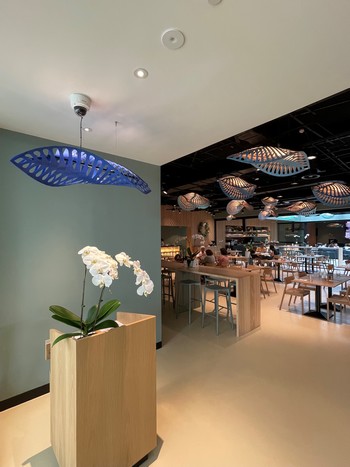NZ Expo in Dubai features David Trubridge biomaterial pendant by Scion
27 January 2022
For immediate release
 Visitors walking into New Zealand’s Expo Restaurant Tiaki in Dubai, will be in awe of the David Trubridge pendant lights suspended above their heads – one of those being made from a shimmering biomaterial formulation developed by Scion.
Visitors walking into New Zealand’s Expo Restaurant Tiaki in Dubai, will be in awe of the David Trubridge pendant lights suspended above their heads – one of those being made from a shimmering biomaterial formulation developed by Scion.
Showcasing New Zealand’s innovative and sustainable spirit, the Navicula pendant light features a composite of sustainable bio-based plastics and native pāua shells developed by Scion scientists with a beautiful iridescent sparkle.
The Navicula design is inspired by microscopic diatoms which live in water and produce 50 percent of the oxygen in the air we breathe. Designer David Trubridge is a recognised leader in sustainable design for his high-end lighting that is produced with minimal environmental impact.
Trubridge says he was asked by New Zealand Trade & Enterprise (NZTE) to develop an installation and so he created custom colour navicula pendant lights, working through the three hospitality spaces from blue to green, with a Scion biomaterial light overhead at the entrance of the Tiaki Restaurant reception to greet visitors. So far there have been 700,000 visitors to the New Zealand pavilion.
“The main objective of working with Scion is to show what’s possible, and hopefully as the commercial environment changes, to make it more attractive for companies to take up the baton to move away from oil-based plastics,” Trubridge explains.
“Scion have been experimenting with New Zealand materials to make biomaterial colour. They’ve used kiwifruit to make green, harakeke (flax) to make brown, the pāua added more of a glitter effect.
“I love the pāua navicula pendant light they developed because it’s different - the light shines through, the colour works well. The whole way along we said it’s important to get a texture, as we didn’t want it to have a glossy shine that made it look like plastic. Scion achieved a rough texture which is important - it works really well, it’s quite different to our plywood lights and I like that.”
Scion Materials, Engineering and Manufacturing Research Group Leader Marie Joo Le Guen says it is a fantastic showcase of the utilisation of biomaterials in an everyday product.
“Scion’s mission and vision is transitioning New Zealand from a linear to a circular bioeconomy. To achieve this, working with artists, designers, teachers or educators, is one of the most important parts of our job. It allows us to bring our innovative biomaterials and bioproducts to life, while taking people on the journey.”
Scion’s biomaterials technology platform takes biomass fillers, such as sander dust, kiwifruit hair and skin, seashells, grape marc, harakeke, bark or casein and combines them with biobased polymers. Compounding the filler with the polymer creates a biocomposite which is then extruded or reshaped into a new form that can be used.
“This navicula pendant project’s success is the result of a 12-year partnership with David Trubridge based on a shared vision towards sustainability and kaitiakitanga,” she says.
The Scion Navicula team had a great time working on the project, with Marie Joo Le Guen, Jamie Agnew, Maxime Barbier, Regis Risani and Rob Whitton all involved.
New Zealand’s Commissioner-General to Expo 2020 Dubai Clayton Kimpton says Tiaki’s design not only showcases our ideas and culture but New Zealand’s spirit of ingenuity and creativity.
“As kaitiaki (guardians), New Zealanders believe we have a responsibility to leave the world in a better place for future generations – and we can see this in the shared sustainability ethos of the design companies.”
Trubridge adds “it’s wonderful to be part of New Zealand’s creative community on exhibit in Dubai – to be there telling the story of our land and our people”.
The inspiration for New Zealand’s Expo 2020 Pavilion Restaurant Tiaki
Each bespoke design in Tiaki Restaurant reflects New Zealand’s Expo theme of ‘Care for People and Place’ - the indigenous Māori environmental ethos of kaitiakitanga and the idea there is a deep, inextricable connection and responsibility between people and the environment. Some of the country’s best-loved sustainable brands for soft furnishings, tableware, and furniture feature.
Located in the Expo’s Sustainability District, the design story begins at the pavilion’s kinetic façade by Kaynemaile, which moves in time with a low-frequency sound to create a rippling pulse effect. This is a reference to the mauri, or life-force within the pavilion - a Māori worldview that everything has a life principle.
The pavilion’s custom type rauponga design was developed by Jasmax in partnership with Haumi. The lines, notches, and curves of the design represent the fern leaf and the ribs of an ancestor symbolising protection, care and connection to the land.
